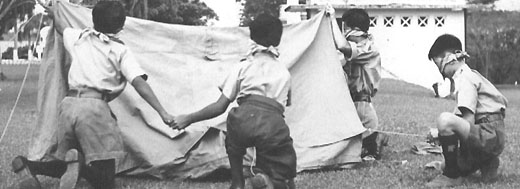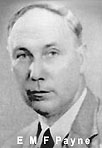
One of the biggest advantages of the V.I. Troops of this
period was having skilled leadership. The Chief Commissioner of Scouting for
Malaya, Mr E.M.F. Payne, replaced Mr F. Daniel as the V.I. Headmaster
in 1949 and served until 1952. Not only was he eminently qualified in
imparting Scouting skills and networking the V.I. Scouts with Scout elsewhere;
 he also provided constant support and encouragement. Evidence of progress
during his tenure abounds: the V.I. produced the first post-war King Scout
for Kuala Lumpur in 1950; K Yogarajah was the sole representative of
Selangor to the 1951 World Scout Jamboree in Austria, an event which Mr
Payne also attended. (See My Trip to Austria
(1951)). Mr Payne also continued the tradition set of some former
Headmasters who officiated at Investiture ceremonies of the Scouts. Another
important figure in the V.I. Scout movement was Mr Geoffrey Geldard, fondly
known as ‘Skipper’, who became the Scout Master of the Second KL Seniors in
1954. Prior to that, he was the Squadron Leader for the No. 1 Squadron of the
Federation of Malaya Air Training Corps and also Commandant of the Federation
of Malaya Air Training Corps, which were no mean roles indeed. So the Scouts
had much to gain from him.
he also provided constant support and encouragement. Evidence of progress
during his tenure abounds: the V.I. produced the first post-war King Scout
for Kuala Lumpur in 1950; K Yogarajah was the sole representative of
Selangor to the 1951 World Scout Jamboree in Austria, an event which Mr
Payne also attended. (See My Trip to Austria
(1951)). Mr Payne also continued the tradition set of some former
Headmasters who officiated at Investiture ceremonies of the Scouts. Another
important figure in the V.I. Scout movement was Mr Geoffrey Geldard, fondly
known as ‘Skipper’, who became the Scout Master of the Second KL Seniors in
1954. Prior to that, he was the Squadron Leader for the No. 1 Squadron of the
Federation of Malaya Air Training Corps and also Commandant of the Federation
of Malaya Air Training Corps, which were no mean roles indeed. So the Scouts
had much to gain from him.
Indeed, the V.I. Scouts quickly regained their high levels of
Scouting efficiency after the War because the Troops were led by skilled and
dedicated leaders such as Mr Payne and Mr Geldard. There were also external
instructors, such as Dr S. Perambalam, who instructed the Scouts in First
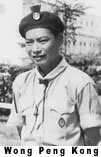 Aid when the class was revived in early May 1948. Scouts who had progressed
through the ranks to become Senior members of the Troops were entrusted with
ASM positions. Later, when the Rover Troops were formed, the ASM’s were drawn
from among the Rovers, as has been mentioned. And just as before the War,
some old Scouts, after finishing their studies at the V.I., returned to take
up Scout Master positions in the Troop such as Mr D.G. Piyasena, Mr Wong Peng
Kong and Mr Chin Peng Lam. Mr Wong Peng Kong was the Troop Leader of the Fourth
Selangor Troop in 1948. Even though he held a job outside the V.I., he returned
as the Scout Master for the Seniors of First KL in 1952. He was later credited
for motivating many First KL Scouts to become Pengakap Raja, particularly in
the late 1950’s and early 1960’s, when he also held the post of Assistant
District Commissioner. Mr Chin Peng Lam was another redoubtable stalwart in
the V.I. Scout movement during the early to mid 1950’s. Under him, as Ooi Boon
Teck (former First KL ASM) recalls, ‘Second KL outshone First KL’. A member of
Fourth KL during his days as a V.I. School boy, Mr Chin then took up the
position of First KL ASM in 1951, before moving to become SM of Second KL
in 1952. He was the youngest ever Woodbadge holder in Malaya then (the Woodbadge
is the official qualification as a Scout Master). Under Mr Chin, Second KL
achieved much success (see An Evening with Two Former
Scout Masters (2001)).
Aid when the class was revived in early May 1948. Scouts who had progressed
through the ranks to become Senior members of the Troops were entrusted with
ASM positions. Later, when the Rover Troops were formed, the ASM’s were drawn
from among the Rovers, as has been mentioned. And just as before the War,
some old Scouts, after finishing their studies at the V.I., returned to take
up Scout Master positions in the Troop such as Mr D.G. Piyasena, Mr Wong Peng
Kong and Mr Chin Peng Lam. Mr Wong Peng Kong was the Troop Leader of the Fourth
Selangor Troop in 1948. Even though he held a job outside the V.I., he returned
as the Scout Master for the Seniors of First KL in 1952. He was later credited
for motivating many First KL Scouts to become Pengakap Raja, particularly in
the late 1950’s and early 1960’s, when he also held the post of Assistant
District Commissioner. Mr Chin Peng Lam was another redoubtable stalwart in
the V.I. Scout movement during the early to mid 1950’s. Under him, as Ooi Boon
Teck (former First KL ASM) recalls, ‘Second KL outshone First KL’. A member of
Fourth KL during his days as a V.I. School boy, Mr Chin then took up the
position of First KL ASM in 1951, before moving to become SM of Second KL
in 1952. He was the youngest ever Woodbadge holder in Malaya then (the Woodbadge
is the official qualification as a Scout Master). Under Mr Chin, Second KL
achieved much success (see An Evening with Two Former
Scout Masters (2001)).
HALLMARKS AND IDENTITY OF THE SCOUTS
Mr Chin Peng Lam and Mr Wong Peng Kong left many memories in the
hearts of the First and Second KL Scouts. But perhaps above all, their legacies
that stand out are the legacies of the Group Songs. Interestingly, both Mr
Chin and Mr Wong were members of Fourth Selangor/ Fourth KL during their
schoolboy days, yet later they were composing songs for First and Second KL.
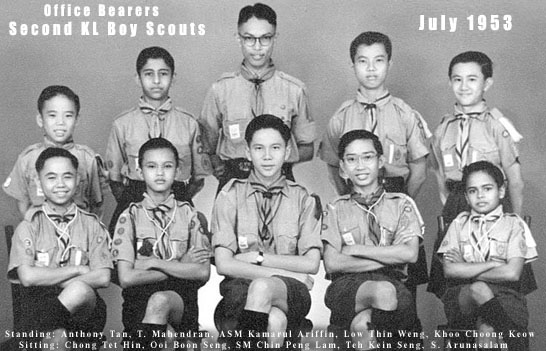
Mr Chin composed the Second KL Group Song, possibly with the help
of a few other people, in the early 1950’s. Set to the tune of It's a Long Way To
Tipperary it goes:
Second KL on parade-ee
Second KL on parade
We are prepared and we are ready
To serve in our country
?????????
????????? (these 2 lines cannot be recalled)
Second KL on parade-ee
Second KL on parade
Around that time, Mr Wong Peng Kong also composed the First
KL Group Song, in collaboration with Mr Geoffrey Geldard (the Scout Master
for the Second KL Seniors!). As Mr Wong recalls, he and Mr Geldard were
relaxing over a cup of coffee as they were wont to do very often, when
they remarked about how they liked a certain Mae West song. Thus, they
set about mapping the appropriate words to the tune, which resulted in
the following lyrics:
Oh, we’re tough! Mighty tough in the group!
For we camp and hike and swim enough for proof.
All our scouting in the open we don’t have the time for loafing,
Oh, we’re tough! Mighty tough in the group!
Singing FIRST KL Scout Group,
Happy band are we,
For we all keep the law as we ought
Yes Sir!
Oh, we’re tough! Mighty tough in the group!
Besides such symbols, other traditions also played an
important role in distinguishing Scouting as an activity that has its own
character. Indeed, character was what it was trying to mould in its members.
One of the inevitable practices of ‘making men out of boys’ was certainly
the hardships it imposed on the boys. For instance, in the 1952
Victorian, the First KL Senior report acknowledged that ‘Investiture
ceremonies were held in which we welcomed, after "dreadful
ragging", many of the Boy Scouts into our Troop…’. And there was
more. General (rtd) Tan Sri Hashim Mohd Ali (see A
Gallery of Scouting Greats) recalls how Mr Chin Peng Lam and Ariff b.
Yahaya (when both were ASM’s of First KL) used to pick up rubbish all over
the campsite and tie them around the necks of the Scouts, for poor
cleanliness and hygiene. Likewise, for traces of soot on pots and pans,
the two ASM’s would hurl all the cooking utensils from the table. Mr Wong
Peng Kong was no more accommodating in his demand for discipline. Besides
stringing pieces of campsite scrap into a necklace and drape it around an
errant PL’s neck, he would bring out a 'supposedly' dirty/used underwear/
brief of his, soak it in a pan of water, and squeeze it over the
offender's head! Unorthodox and unremitting, these practices served to
lift the V.I. Scouts to high levels of efficiency, and with efficiency
comes enjoyment of Scouting, or any other activity for that matter.
In spite of such enthusiasm and activeness, there was one
event that kept a lid on the ability of the Scouts of that era to explore and
test their abilities to the maximum, sometimes even testing the livelihood
of the Scouts. Regrettably, that menacing phenomenon spanned a period of
twelve years. This was the communist insurrection in Malaya.
THE MALAYAN EMERGENCY
The sporadic and random insecurity of the Emergency led to
stringent security restrictions imposed. For the V.I. Scouts, this meant
that apart from Castle Camp, there were not many other campsites to visit.
This meant that apart from the occasional outings to the Lake Gardens
or places in Kuala Lumpur, the choice of destinations for outings were
severely limited. Mountain climbing, such as expeditions up Gunung Tahan,
were basically out of the question. The publication and sales of jungle
maps was definitely banned, so how else could they make their way up
Tahan? Besides, no one was keen on having their throats slit in a surprise
ambush by communist Terrorists, while their Scout friends would have had
to suffer the horror in silent anguish. So before the mid 1950’s, apart
from occasional exceptions, their perimeter of activities enclosed them
within Kuala Lumpur. But was KL all that safe?

The perceived security of Kuala Lumpur in fact belied the
furtive dangers of the Min Yuen lurking in the back alleys of the Cochrane
Road government quarters, or shrouded behind the shrubbery of the Kampung
Pandan civil servant bungalows; or they could be as brazen as to operate
from a cell hidden inside a coffee shop opposite Castle Camp where the
Federal Defence headquarters were! Ooi Boon Teck, former First KL ASM,
recalls that an innocuous coffee shop sandwiched between Castle Camp
and the Police Barracks along Rifle Range Road was manned by people who
were eventually arrested for spying. And to think that in the early
1950's, this mischievous Scout would sneak out of Camp to indulge in a tasty
roti kaya at that shop! This was in the middle of the centre for
security and military intelligence for the nation - the Police Barracks
and Defence Department.
If such threats prowled along the streets of this centre of
intelligence, what more then were the risks on the fringes of Kuala Lumpur,
where the V.I. Scout would make his weekend trek or hike? For instance, in 1958,
Tai Kon Heng of First KL went on a hike in the tin mining area south of Kampung
Pandan, with a non-Scout schoolmate. Miscalculating the time to return to
their bikes, they failed to complete the hike before daylight faded. Suddenly
in the darkness a blinding beam was aimed at them from a hundred metres
away - the sentry or sentries guarding the mines must have thought that the
two V.I. boys were bandits out to sabotage mining equipment. If not for Kon
Heng’s Scout uniform, a clatter of Sten gun fire would probably have followed
and there would have been two fewer VI boys turning up at school the next
day! Possibly "they" figured that the two boys were harmless, since
one of them was a Scout and the other was perhaps a Scout who wasn’t wearing
his uniform. After what seemed an eternity, the unseen eyes must have been
satisfied, the searchlight was switched off and the two V.I. Boys scurried
off into the darkness, none the worse for their brush with what could
have been a horrible disaster.
Mindful of the threats and dangers posed by the Emergency to
their homeland, the V.I. Scouts did whatever that was within their abilities
to assist in fighting banditry. During Anti-Bandit Month, such as in 1950
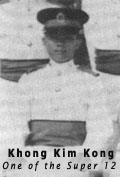 and 1951, the Scouts served as messenger corps for the Government. As
well, the scouts visited the New Villages to popularise Scouting there.
A plan of Sir Harold Briggs and Sir Henry Gurney, the New Village plan
relocated squatters (often Chinese) from the fringe of the jungles to
clusters of guarded areas closer to the towns, where occupants were
allocated plots of soil for agriculture and residence to promote their
loyalty to the land. To reinforce this sense of loyalty, the Scout
Headquarters must have felt it appropriate that the villagers also had
activities like Scouting to occupy their time with. Another contribution
of the V.I. Scouts to their nation came when, in 1952, Khong Kim Kong,
a former Second KL ASM (1950-1951), was selected as an officer cadet
of the embryonic Federation Regiment. Chosen by General Templer, he was
one of a dozen of Malaya's best youths (dubbed the "Super
Twelve" by the press) who were sent for training at the Royal
Military College at Sandhurst, so that they could serve their homeland
as future officers. Sir Gerald Templer, the High Commissioner of Malaya
from 1952 to 1954, took much interest in the talents of the local boys.
In fact he often visited Schools including the V.I. in 1953 – and he
even visited the V.I. Scouts during camps!
and 1951, the Scouts served as messenger corps for the Government. As
well, the scouts visited the New Villages to popularise Scouting there.
A plan of Sir Harold Briggs and Sir Henry Gurney, the New Village plan
relocated squatters (often Chinese) from the fringe of the jungles to
clusters of guarded areas closer to the towns, where occupants were
allocated plots of soil for agriculture and residence to promote their
loyalty to the land. To reinforce this sense of loyalty, the Scout
Headquarters must have felt it appropriate that the villagers also had
activities like Scouting to occupy their time with. Another contribution
of the V.I. Scouts to their nation came when, in 1952, Khong Kim Kong,
a former Second KL ASM (1950-1951), was selected as an officer cadet
of the embryonic Federation Regiment. Chosen by General Templer, he was
one of a dozen of Malaya's best youths (dubbed the "Super
Twelve" by the press) who were sent for training at the Royal
Military College at Sandhurst, so that they could serve their homeland
as future officers. Sir Gerald Templer, the High Commissioner of Malaya
from 1952 to 1954, took much interest in the talents of the local boys.
In fact he often visited Schools including the V.I. in 1953 – and he
even visited the V.I. Scouts during camps!
WHISTLING THROUGH THE RAINDROPS
Despite postwar deprivations and Emergency restrictions, the
Scouts were not to be stopped from pursuing their interests. The Scouts started
off their first Scouting year after the War with a bang – organising around
fourteen parades and two outings in 1946. Spearheaded by SM Mr Fong Chu
Chai, thirty Scouts cycled to Klang Gates where they had a fine time. Then
ASM Rudolf Theodore Lam took ten boys on an experimental camp in Morib.
Measuring such feats against the context of the era, they were colossal
achievements, given that Malayan households were picking up from the
scraps of the war – many families would have preferred their children to
stay home to help with subsistence activities than go to School (what
more join a Scout Troop) and many households lived in poverty.
Parades were held on Saturday morning (1946 and 1947)
and Monday evenings (1948-1950). As the Troops improved their standard,
meetings were held more frequently; in 1950, the Rovers met every alternate
weekend, the Senior and Junior Scouts twice a week and Cubs on every
Saturday. Activities included play-acting, inter-Troop badminton matches,
fishing. Sometimes, in addition to parades, there would be training
courses organised by the Troops. For instance, in 1953, the First KL
Seniors had training course in self-defence, as well as various badges.
In addition, the Scouts (and Cubs) would attend training courses held at
Castle Camp. There were also inter-Group activities. From 1952 to 1954,
the Second KL Scouts won the inter-Group relays, which pitted the three
V.I. Groups against each other. Sports Days also had Scout events which
saw the three Groups competing against each other in activities like
pioneering and First Aid.
Camping and excursions were also greatly looked forward to.
As early as 1947, the Scouts had resumed their former activeness in camping, by
having camps on weekends at Castle Camp and Kenny Hill (now Bukit Tunku).
There were also longer camps (sometimes week-long ones) at places like
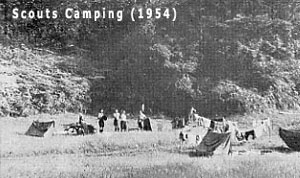 Port Dickson, Malacca, Pangkor, Langkawi, Penang and Singapore. In 1952,
the Second KL Scouts made a visit to Singapore, going there by sea.
Tung Song was the vessel which took Mr Chin Peng Lam and 20 other
boys from Port Swettenham (now Port Klang) there. Commencing with a train
ride from KL to the port on 26 December, the trip kept the boys away from
home for 11 days. From Port Swettenham, the vessel took them to Pulau
Brani, off the main island of Singapore, where it unloaded tin ore.
There, the group took a motor boat to Clifford Pier after which they
journeyed to Sands House (the Scout Headquarters of Singapore) by bus.
They returned to KL by land. In 1954, another sea adventure was undertaken,
this time by the First KL Scouts. Sailing on the S.S. Jalagopal,
the Scouts went to Penang. They visited the island and then hit the trail
to Langkawi Island via Alor Setar. Nonetheless, such long distance travels,
such as to Fraser’s Hill and Cameron Highlands, only became more frequent
in the mid 1950’s because before then, the epoch saw massive security risks
posed by the Emergency.
Port Dickson, Malacca, Pangkor, Langkawi, Penang and Singapore. In 1952,
the Second KL Scouts made a visit to Singapore, going there by sea.
Tung Song was the vessel which took Mr Chin Peng Lam and 20 other
boys from Port Swettenham (now Port Klang) there. Commencing with a train
ride from KL to the port on 26 December, the trip kept the boys away from
home for 11 days. From Port Swettenham, the vessel took them to Pulau
Brani, off the main island of Singapore, where it unloaded tin ore.
There, the group took a motor boat to Clifford Pier after which they
journeyed to Sands House (the Scout Headquarters of Singapore) by bus.
They returned to KL by land. In 1954, another sea adventure was undertaken,
this time by the First KL Scouts. Sailing on the S.S. Jalagopal,
the Scouts went to Penang. They visited the island and then hit the trail
to Langkawi Island via Alor Setar. Nonetheless, such long distance travels,
such as to Fraser’s Hill and Cameron Highlands, only became more frequent
in the mid 1950’s because before then, the epoch saw massive security risks
posed by the Emergency.
Meanwhile, excursions included overnight hikes, treks and
day outings. Destinations for outings included Klang and Port Swettenham.
Sometimes, excursions were simply in pursuit of a leisurely hobby such as
fishing. The boys relished opportunities to see the areas outside the familiar
city surroundings, even if it meant travelling along bumpy laterite or gravel
roads, or going on uncomfortable bus rides or boarding rickety fishing boats.
Perhaps the first semi-trans-Peninsula excursion was undertaken in 1950, when
ASM Khong Kim Kong (Boy Scout ASM of Second KL) and SM D.G. Piyasena (Boy Scout
SM of Fourth KL), who both also belonged to the First KL Rover Crew, cycled to
Singapore. Possibly buoyed by their success, another group of Rovers from the
First KL Crew covered 150 miles on bicycles in pursuit of the Rambler’s Badge.
Of course, excursions were an essential element of Fourth KL
activities, especially after transforming itself into an Air Scout Group. In 1951,
they received instruction and guidance from the Meteorological Department,
particularly through the person of Mr Hwang
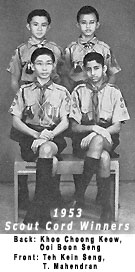 Tiow. Later that year, two Air Scouts had an opportunity to fly to
Penang and back, in a Dakota. Then in 1953, the Group was permitted by
the Commanding Officer of the Royal Air Force (KL Unit) to visit the
aerodrome (the present Malaysian Air Force base at Jalan Lapangan
Terbang at Jalan Sungai Besi) from time to time. The Commanding Officer
also allowed them to study the different types of aircraft and engines
under the guidance of R.A.F. officers like the Airport Manager. Such
permission granted to the V.I. Scouts was indeed significant, as there
was tight security on defence centres and strategic ammunition in
those days of the Emergency.
Tiow. Later that year, two Air Scouts had an opportunity to fly to
Penang and back, in a Dakota. Then in 1953, the Group was permitted by
the Commanding Officer of the Royal Air Force (KL Unit) to visit the
aerodrome (the present Malaysian Air Force base at Jalan Lapangan
Terbang at Jalan Sungai Besi) from time to time. The Commanding Officer
also allowed them to study the different types of aircraft and engines
under the guidance of R.A.F. officers like the Airport Manager. Such
permission granted to the V.I. Scouts was indeed significant, as there
was tight security on defence centres and strategic ammunition in
those days of the Emergency.
Pioneering is one activity that tests an entire gamut of
Scouting capabilities, ranging from physical fitness, to axemanship to knots.
There was no shortage of such tests of engineering capabilities during
this epoch. For example, in 1951, the First KL Rovers had to build a
bridge across the Klang River. In 1954, in conjunction with the Diamond
Jubilee Exhibition of the V.I., the Scouts erected a monkey bridge, a
tree-top platform, a shelter and models of Pioneering projects. There
was also a demonstration of Backwoodsman cooking for that Exhibition.
Earlier in the year, on 2 May, the Second KL Scouts constructed a
Bushman’s Bridge as a display during the farewell of Chief Scout General
Sir Gerald Templer. They were heartily congratulated for their product.
In that same year, both First and Second KL lashed up rafts and cruised
down the Gombak River.
There were also intellectual activities. For instance,
in 1950, there were lectures on International Trade (by Mr A.W. Pinnick),
Drama (by Mrs A.W. Pinnick) and British Parliamentary Elections of 1950 (by
Miss Josephine Foss the then headmistress of Pudu English School). These
lectures were given to the Rovers. The Rovers also visited the factory of Fraser
and Neave, where they were escorted around on a tour by none other than Messrs
Fraser and Neave themselves. On other occasions, the Rover activities included
dramatics and visits to places such as Pudu Gaol. In 1953, the Second KL Scout
Group published its first Group magazine, under the name of Second KL Gazette.
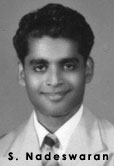 Kamarul ‘Blue Panther’ Ariffin (see A Gallery
of Scouting Greats) and Ooi Boon Leong were the first editors of that
termly magazine, which contained articles contributed by the Scouts of the Group.
Kamarul ‘Blue Panther’ Ariffin (see A Gallery
of Scouting Greats) and Ooi Boon Leong were the first editors of that
termly magazine, which contained articles contributed by the Scouts of the Group.
Then there were the Scout Shows. In the 1949 Victorian,
there are two entries relating to the dates 24 October 1948 and 6
March 1949, dates when the V.I. Scout Shows were broadcast over Radio
Malaya. No details exist regarding the shows. There was also a Gang
Show in 1949, in which no fewer than 30 V.I. Scouts took part. The
show included the performance of the Malayan version of Sir Walter Scott's
epic Young Lochinvar, entitled Young Nadesa, written by S.
Nadeswaran, who was the TL of First Selangor in 1948. A versatile stage
personality who could sing or play his Shakespeare role, Nadeswaran
parodied Lochinvar in the poem of how a gallant Nadesa snatched
his willing bride from the scene of the wedding, and while they escaped
across ‘bush, bank and lallang’, they were pursued by ‘Raleigh
bikes’, and that
There was planning among the Prefects of the Victoria
Institution,
Boy Scouts, monitors, P.T. leaders, they rode in confusion…
Those radio appearances were not the last brushes of fame that
the V.I. Scouts had with the national broadcaster. In 1953, another opportunity
came. That year, the Malayan Film Unit (now Filem Negara Malaysia) produced a
twelve-minute documentary to illuminate the nation about the ideals and activities
of the scout movement. (MFU documentaries were normally screened with the trailers
before the main feature in cinemas around the country.) Entitled
 Chik’s Great Adventure, its main stars were the Second KL
Scouts. The role of Chik was filled by Raja Iskandar Shah. Other
Scouts in the show were S. Arunasalam (playing a boy inspired by Chik
to join the Scouts), M. Shanmughalingam (see A
Gallery of Scouting Greats), SM Mr Chin Peng Lam and many others.
Together with Castle Camp, the V.I. was one of the film locations,
with many Victorians as extras. This Second KL feat was noted in an
article in the Malay Mail that year.
Chik’s Great Adventure, its main stars were the Second KL
Scouts. The role of Chik was filled by Raja Iskandar Shah. Other
Scouts in the show were S. Arunasalam (playing a boy inspired by Chik
to join the Scouts), M. Shanmughalingam (see A
Gallery of Scouting Greats), SM Mr Chin Peng Lam and many others.
Together with Castle Camp, the V.I. was one of the film locations,
with many Victorians as extras. This Second KL feat was noted in an
article in the Malay Mail that year.
In 1953, too, there was a variety show called Fiesta,
the purpose of which was to raise funds for the Malayan Scouts Headquarters
building. First, Second and Fourth KL Scout Groups collaborated in the
project, which was put up on 18 September. Charging a meagre 50 cents,
$1 or $2 for entry fees, the Fiesta had performances as well
as singing sessions (with songs like Sons Of The Sea and
From Cotton Fields To New Orleans). With the assistance of
other groups like the Malayan Arts and Theatre Group which lent them
spotlights and screens, the scouts raised $1,319.30, a king’s ransom
in those days.
STRONG SCOUTING FIBRE
Scouting fibre involves making friends with everyone
around. Thus, the V.I. Scouts attended activities which involved other
Troops. In 1946, they attended the Selangor Scout Troop rally on
November 9 at the Coronation Park (now the area occupied by Stadium
Merdeka and Stadium Negara). Then there were the international
jamborees, including the Pan-Pacific Jamboree held in Australia (see
The Pan-Pacific Jamboree (1948-1949))
and the World Jamboree held in Austria in 1951 (see My Trip to Austria (1951) ). In 1952,
there was a South-East Asia Patrol Camp, after which the Second KL
Boy Scouts entertained the Cambodian and French Scouts for a week. Even
the Cubs were not left behind. The First All-Malayan Cub Corroborree
was held in 1952, and the Second KL Pack was represented at the event
by its ACM Che Bakri Budin and three Cubs. That year too saw the Cub
Master Player, at which the Second KL Cubs were also represented. In
the 1953 Champoree Inter-contingent Shield at the Kijang Camp in
Kelantan, SM Chin Peng Lam led the Selangor contingent (which included
the V.I. Scouts).
As good turns are a crucial part of the Scouting
character, community service was never neglected. The following is a
sample of good turns served by the V.I. Troops during this epoch. There
were many other community services, but not all have been recorded with
sufficient detail, so this table only lists a selection of them:
|
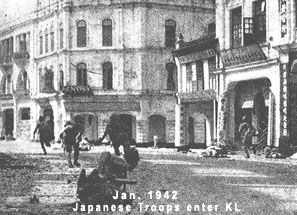
 his was a period of upheaval, and the V.I. was an unwitting victim.
When the Japanese occupied Malaya for almost four years, Scouting activities
followed the other activities of the V.I. into a temporary eclipse. The
Japanese aimed to ensure that ‘the minds of future generations of Malai
trained from the start to follow the lines of Shin Chitsujo (New Order) and
discard Western ideas and habits’, a maxim stated in the Syonan Sinbun
6 May 2603. English schools, such as the V.I., were either not allowed to
operate at all or were re-opened as Japanese Schools. Certainly Scouting activities,
seen as having an Imperial British Military heritage, could not take place.
his was a period of upheaval, and the V.I. was an unwitting victim.
When the Japanese occupied Malaya for almost four years, Scouting activities
followed the other activities of the V.I. into a temporary eclipse. The
Japanese aimed to ensure that ‘the minds of future generations of Malai
trained from the start to follow the lines of Shin Chitsujo (New Order) and
discard Western ideas and habits’, a maxim stated in the Syonan Sinbun
6 May 2603. English schools, such as the V.I., were either not allowed to
operate at all or were re-opened as Japanese Schools. Certainly Scouting activities,
seen as having an Imperial British Military heritage, could not take place.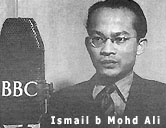 Teck was a Colonel in the Chinese Army fighting in Burma. After the War,
he was promoted to an important post in the Canton Government. ASM Rajion
b. Hakim was in the Red Cross section of the F.M.S.V.F. (Federated Malay
States Volunteer Forces) Light Battery Section. ASM Ismail b. Mohd Ali (see
A Gallery of Scouting Greats), while at Cambridge
University on a Queen’s Scholarship, was a regular voice over the BBC radio
during the War. Upon return to Malaya, he joined the Malayan Civil Service.
PL Chang Sow Khong was an Artillery Sergeant with the Australian Army, fighting
in New Guinea and the Philippines and was later attached to General Douglas
McArthur’s headquarters as an Intelligence Officer. Bun Tsan Chuan was a
member of the F.M.S.F.V. Field Ambulance Section. His distinguished services
during the Malayan Campaign won him the Military Medal. The 1946
Victorian notes that apart from these names, there was a host of
others who served creditably during the Dai Toa Senso (Great East Asian War)
"which space prevented it from recording. Everyone of them has a good
word to say for Scouting and its usefulness".
Teck was a Colonel in the Chinese Army fighting in Burma. After the War,
he was promoted to an important post in the Canton Government. ASM Rajion
b. Hakim was in the Red Cross section of the F.M.S.V.F. (Federated Malay
States Volunteer Forces) Light Battery Section. ASM Ismail b. Mohd Ali (see
A Gallery of Scouting Greats), while at Cambridge
University on a Queen’s Scholarship, was a regular voice over the BBC radio
during the War. Upon return to Malaya, he joined the Malayan Civil Service.
PL Chang Sow Khong was an Artillery Sergeant with the Australian Army, fighting
in New Guinea and the Philippines and was later attached to General Douglas
McArthur’s headquarters as an Intelligence Officer. Bun Tsan Chuan was a
member of the F.M.S.F.V. Field Ambulance Section. His distinguished services
during the Malayan Campaign won him the Military Medal. The 1946
Victorian notes that apart from these names, there was a host of
others who served creditably during the Dai Toa Senso (Great East Asian War)
"which space prevented it from recording. Everyone of them has a good
word to say for Scouting and its usefulness".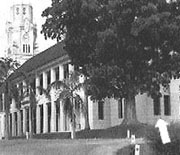 the Scouts did not have to wait long after the War before another room was
allocated to them. On 20 January 1949, the School approved their use of the
former Cadet Armoury (on the corner of the School near the side entrance) as
the new Scout Room. It was to become their abode for 8 years, until early
1967 when they moved to the Jaga’s Hut opposite the V.I.O.B.A. building.
Another setback from the War was that there were no uniforms available.
When uniforms were finally obtained in 1947, the Scouts had to pay for them,
unlike the pre-war period where the uniforms were supplied for free. This
posed new challenges for the economy and thrift of the Boys, especially as
the years immediately following the War were years of rife poverty; after
all, the thousands of Banana money currency were now obsolete. So, in 1950,
for example, the Cubs did work by selling chocolates and Rovers collected
money by organising bicycle parks during football matches.
the Scouts did not have to wait long after the War before another room was
allocated to them. On 20 January 1949, the School approved their use of the
former Cadet Armoury (on the corner of the School near the side entrance) as
the new Scout Room. It was to become their abode for 8 years, until early
1967 when they moved to the Jaga’s Hut opposite the V.I.O.B.A. building.
Another setback from the War was that there were no uniforms available.
When uniforms were finally obtained in 1947, the Scouts had to pay for them,
unlike the pre-war period where the uniforms were supplied for free. This
posed new challenges for the economy and thrift of the Boys, especially as
the years immediately following the War were years of rife poverty; after
all, the thousands of Banana money currency were now obsolete. So, in 1950,
for example, the Cubs did work by selling chocolates and Rovers collected
money by organising bicycle parks during football matches.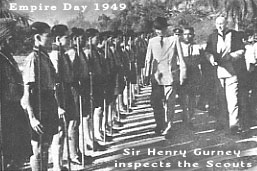

 he also provided constant support and encouragement. Evidence of progress
during his tenure abounds: the V.I. produced the first post-war King Scout
for Kuala Lumpur in 1950; K Yogarajah was the sole representative of
Selangor to the 1951 World Scout Jamboree in Austria, an event which Mr
Payne also attended. (See
he also provided constant support and encouragement. Evidence of progress
during his tenure abounds: the V.I. produced the first post-war King Scout
for Kuala Lumpur in 1950; K Yogarajah was the sole representative of
Selangor to the 1951 World Scout Jamboree in Austria, an event which Mr
Payne also attended. (See  Aid when the class was revived in early May 1948. Scouts who had progressed
through the ranks to become Senior members of the Troops were entrusted with
ASM positions. Later, when the Rover Troops were formed, the ASM’s were drawn
from among the Rovers, as has been mentioned. And just as before the War,
some old Scouts, after finishing their studies at the V.I., returned to take
up Scout Master positions in the Troop such as Mr D.G. Piyasena, Mr Wong Peng
Kong and Mr Chin Peng Lam. Mr Wong Peng Kong was the Troop Leader of the Fourth
Selangor Troop in 1948. Even though he held a job outside the V.I., he returned
as the Scout Master for the Seniors of First KL in 1952. He was later credited
for motivating many First KL Scouts to become Pengakap Raja, particularly in
the late 1950’s and early 1960’s, when he also held the post of Assistant
District Commissioner. Mr Chin Peng Lam was another redoubtable stalwart in
the V.I. Scout movement during the early to mid 1950’s. Under him, as Ooi Boon
Teck (former First KL ASM) recalls, ‘Second KL outshone First KL’. A member of
Fourth KL during his days as a V.I. School boy, Mr Chin then took up the
position of First KL ASM in 1951, before moving to become SM of Second KL
in 1952. He was the youngest ever Woodbadge holder in Malaya then (the Woodbadge
is the official qualification as a Scout Master). Under Mr Chin, Second KL
achieved much success (see
Aid when the class was revived in early May 1948. Scouts who had progressed
through the ranks to become Senior members of the Troops were entrusted with
ASM positions. Later, when the Rover Troops were formed, the ASM’s were drawn
from among the Rovers, as has been mentioned. And just as before the War,
some old Scouts, after finishing their studies at the V.I., returned to take
up Scout Master positions in the Troop such as Mr D.G. Piyasena, Mr Wong Peng
Kong and Mr Chin Peng Lam. Mr Wong Peng Kong was the Troop Leader of the Fourth
Selangor Troop in 1948. Even though he held a job outside the V.I., he returned
as the Scout Master for the Seniors of First KL in 1952. He was later credited
for motivating many First KL Scouts to become Pengakap Raja, particularly in
the late 1950’s and early 1960’s, when he also held the post of Assistant
District Commissioner. Mr Chin Peng Lam was another redoubtable stalwart in
the V.I. Scout movement during the early to mid 1950’s. Under him, as Ooi Boon
Teck (former First KL ASM) recalls, ‘Second KL outshone First KL’. A member of
Fourth KL during his days as a V.I. School boy, Mr Chin then took up the
position of First KL ASM in 1951, before moving to become SM of Second KL
in 1952. He was the youngest ever Woodbadge holder in Malaya then (the Woodbadge
is the official qualification as a Scout Master). Under Mr Chin, Second KL
achieved much success (see 

 and 1951, the Scouts served as messenger corps for the Government. As
well, the scouts visited the New Villages to popularise Scouting there.
A plan of Sir Harold Briggs and Sir Henry Gurney, the New Village plan
relocated squatters (often Chinese) from the fringe of the jungles to
clusters of guarded areas closer to the towns, where occupants were
allocated plots of soil for agriculture and residence to promote their
loyalty to the land. To reinforce this sense of loyalty, the Scout
Headquarters must have felt it appropriate that the villagers also had
activities like Scouting to occupy their time with. Another contribution
of the V.I. Scouts to their nation came when, in 1952, Khong Kim Kong,
a former Second KL ASM (1950-1951), was selected as an officer cadet
of the embryonic Federation Regiment. Chosen by General Templer, he was
one of a dozen of Malaya's best youths (dubbed the "Super
Twelve" by the press) who were sent for training at the Royal
Military College at Sandhurst, so that they could serve their homeland
as future officers. Sir Gerald Templer, the High Commissioner of Malaya
from 1952 to 1954, took much interest in the talents of the local boys.
In fact he often visited Schools including the V.I. in 1953 – and he
even visited the V.I. Scouts during camps!
and 1951, the Scouts served as messenger corps for the Government. As
well, the scouts visited the New Villages to popularise Scouting there.
A plan of Sir Harold Briggs and Sir Henry Gurney, the New Village plan
relocated squatters (often Chinese) from the fringe of the jungles to
clusters of guarded areas closer to the towns, where occupants were
allocated plots of soil for agriculture and residence to promote their
loyalty to the land. To reinforce this sense of loyalty, the Scout
Headquarters must have felt it appropriate that the villagers also had
activities like Scouting to occupy their time with. Another contribution
of the V.I. Scouts to their nation came when, in 1952, Khong Kim Kong,
a former Second KL ASM (1950-1951), was selected as an officer cadet
of the embryonic Federation Regiment. Chosen by General Templer, he was
one of a dozen of Malaya's best youths (dubbed the "Super
Twelve" by the press) who were sent for training at the Royal
Military College at Sandhurst, so that they could serve their homeland
as future officers. Sir Gerald Templer, the High Commissioner of Malaya
from 1952 to 1954, took much interest in the talents of the local boys.
In fact he often visited Schools including the V.I. in 1953 – and he
even visited the V.I. Scouts during camps!  Port Dickson, Malacca, Pangkor, Langkawi, Penang and Singapore. In 1952,
the Second KL Scouts made a visit to Singapore, going there by sea.
Tung Song was the vessel which took Mr Chin Peng Lam and 20 other
boys from Port Swettenham (now Port Klang) there. Commencing with a train
ride from KL to the port on 26 December, the trip kept the boys away from
home for 11 days. From Port Swettenham, the vessel took them to Pulau
Brani, off the main island of Singapore, where it unloaded tin ore.
There, the group took a motor boat to Clifford Pier after which they
journeyed to Sands House (the Scout Headquarters of Singapore) by bus.
They returned to KL by land. In 1954, another sea adventure was undertaken,
this time by the First KL Scouts. Sailing on the S.S. Jalagopal,
the Scouts went to Penang. They visited the island and then hit the trail
to Langkawi Island via Alor Setar. Nonetheless, such long distance travels,
such as to Fraser’s Hill and Cameron Highlands, only became more frequent
in the mid 1950’s because before then, the epoch saw massive security risks
posed by the Emergency.
Port Dickson, Malacca, Pangkor, Langkawi, Penang and Singapore. In 1952,
the Second KL Scouts made a visit to Singapore, going there by sea.
Tung Song was the vessel which took Mr Chin Peng Lam and 20 other
boys from Port Swettenham (now Port Klang) there. Commencing with a train
ride from KL to the port on 26 December, the trip kept the boys away from
home for 11 days. From Port Swettenham, the vessel took them to Pulau
Brani, off the main island of Singapore, where it unloaded tin ore.
There, the group took a motor boat to Clifford Pier after which they
journeyed to Sands House (the Scout Headquarters of Singapore) by bus.
They returned to KL by land. In 1954, another sea adventure was undertaken,
this time by the First KL Scouts. Sailing on the S.S. Jalagopal,
the Scouts went to Penang. They visited the island and then hit the trail
to Langkawi Island via Alor Setar. Nonetheless, such long distance travels,
such as to Fraser’s Hill and Cameron Highlands, only became more frequent
in the mid 1950’s because before then, the epoch saw massive security risks
posed by the Emergency. Tiow. Later that year, two Air Scouts had an opportunity to fly to
Penang and back, in a Dakota. Then in 1953, the Group was permitted by
the Commanding Officer of the Royal Air Force (KL Unit) to visit the
aerodrome (the present Malaysian Air Force base at Jalan Lapangan
Terbang at Jalan Sungai Besi) from time to time. The Commanding Officer
also allowed them to study the different types of aircraft and engines
under the guidance of R.A.F. officers like the Airport Manager. Such
permission granted to the V.I. Scouts was indeed significant, as there
was tight security on defence centres and strategic ammunition in
those days of the Emergency.
Tiow. Later that year, two Air Scouts had an opportunity to fly to
Penang and back, in a Dakota. Then in 1953, the Group was permitted by
the Commanding Officer of the Royal Air Force (KL Unit) to visit the
aerodrome (the present Malaysian Air Force base at Jalan Lapangan
Terbang at Jalan Sungai Besi) from time to time. The Commanding Officer
also allowed them to study the different types of aircraft and engines
under the guidance of R.A.F. officers like the Airport Manager. Such
permission granted to the V.I. Scouts was indeed significant, as there
was tight security on defence centres and strategic ammunition in
those days of the Emergency.  Kamarul ‘Blue Panther’ Ariffin (see
Kamarul ‘Blue Panther’ Ariffin (see  Chik’s Great Adventure, its main stars were the Second KL
Scouts. The role of Chik was filled by Raja Iskandar Shah. Other
Scouts in the show were S. Arunasalam (playing a boy inspired by Chik
to join the Scouts), M. Shanmughalingam (see
Chik’s Great Adventure, its main stars were the Second KL
Scouts. The role of Chik was filled by Raja Iskandar Shah. Other
Scouts in the show were S. Arunasalam (playing a boy inspired by Chik
to join the Scouts), M. Shanmughalingam (see 